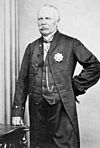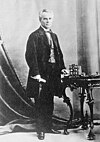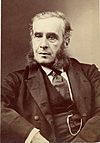
The Province of Canada was a British colony in British North America from 1841 to 1867. Its formation reflected recommendations made by John Lambton, 1st Earl of Durham, in the Report on the Affairs of British North America following the Rebellions of 1837–1838.

Sir George-Étienne Cartier, 1st Baronet, was a Canadian statesman and Father of Confederation. The English spelling of the name—George, instead of Georges, the usual French spelling—is explained by his having been named in honour of King George III.

The Quebec Liberal Party is a provincial political party in Quebec. It has been independent of the federal Liberal Party of Canada since 1955. The QLP has always been associated with the colour red; each of their main opponents in different eras have been generally associated with the colour blue.

George Brown was a British-Canadian journalist, politician and one of the Fathers of Confederation. He attended the Charlottetown and Quebec conferences. A noted Reform politician, he is best known as the founder and editor of the Toronto Globe, Canada's most influential newspaper at the time, and his leadership in the founding of the Liberal Party in 1867. He was an articulate champion of the grievances and anger of Upper Canada (Ontario). He played a major role in securing national unity. His career in active politics faltered after 1865, but he remained a powerful spokesman for the Liberal Party. He promoted westward expansion and opposed the policies of Conservative Prime Minister John A. Macdonald.
Joint premiers of the Province of Canada were the prime ministers of the Province of Canada, from the 1841 unification of Upper Canada and Lower Canada until Confederation in 1867.
The Liberal-Conservative Party was the formal name of the Conservative Party of Canada until 1873, and again from 1922 to 1938, although some Conservative candidates continued to run under the label as late as the 1911 election and others ran as simple Conservatives before 1873. In many of Canada's early elections, there were both "Liberal-Conservative" and "Conservative" candidates; however, these were simply different labels used by candidates of the same party. Both were part of Sir John A. Macdonald's government and official Conservative and Liberal-Conservative candidates would not, generally, run against each other. It was also common for a candidate to run on one label in one election and the other in a subsequent election.
The Constitutional debate of Canada is an ongoing debate covering various political issues regarding the fundamental law of the country. The debate can be traced back to the Royal Proclamation, issued on October 7, 1763, following the signing of the Treaty of Paris (1763) wherein France ceded most of New France to Great Britain in favour of keeping Guadeloupe.

The 1867 Quebec general election was held in August and September 1867 to elect members of the First Legislature for the Province of Quebec, Canada. The Quebec Conservative Party, led by Premier Pierre-Joseph-Olivier Chauveau, defeated the Quebec Liberal Party led by Henri-Gustave Joly de Lotbinière.
The Parti rouge was a political group that contested elections in the Eastern section of the Province of Canada. It was formed around 1847 by radical French-Canadians inspired by the ideas of Louis-Joseph Papineau, the Institut canadien de Montréal, and the reformist movement led by the Parti patriote of the 1830s.
The Conservative Party of Quebec was a political party in Quebec, Canada, from 1867 until 1936, when it merged with members of the Action libérale nationale to form the Union Nationale.
Liberalism has been a major trend in Canadian politics since the late 18th century. Canada has the same features of other liberal democracies in the Western democratic political tradition. This article gives an overview of liberalism in Canada. It includes a brief history of liberal parties with substantial representation in parliament.

Joseph-Édouard Cauchon, was a prominent Quebec politician in the middle years of the nineteenth-century. Although he held a variety of portfolios at the federal, provincial and municipal levels, he never achieved his goal of becoming the Premier of Quebec.
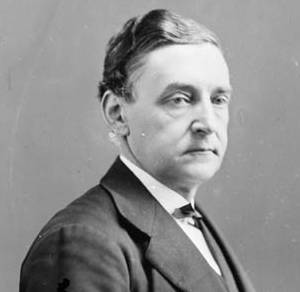
Sir Antoine-Aimé Dorion was a French Canadian politician and jurist.

The Great Coalition was a grand coalition of political parties that brought an end to political deadlock in the Province of Canada. It existed from May 1864 until Confederation in 1867.
Conservatism in Canada is generally considered a movement which is primarily represented by the modern-day Conservative Party of Canada in federal party politics, as well as various centre-right and right-wing parties at the provincial level. Far-right politics have never been a prominent force in Canadian society. The first party which called itself "Conservative" in what would become Canada was elected in the Province of Canada election of 1854.
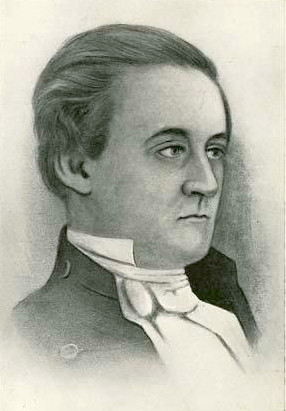
Lewis Thomas Drummond was a lawyer, political figure, and judge in Lower Canada.

The Double Shuffle was a political episode in the Province of Canada in 1858. It began on July 28, 1858, when the coalition government of John A. Macdonald (Liberal-Conservative) and George-Étienne Cartier (Bleu) was defeated on a confidence vote in the Legislative Assembly of the Province of Canada, concerning the location of the seat of government for the Province. The government resigned the next day.


